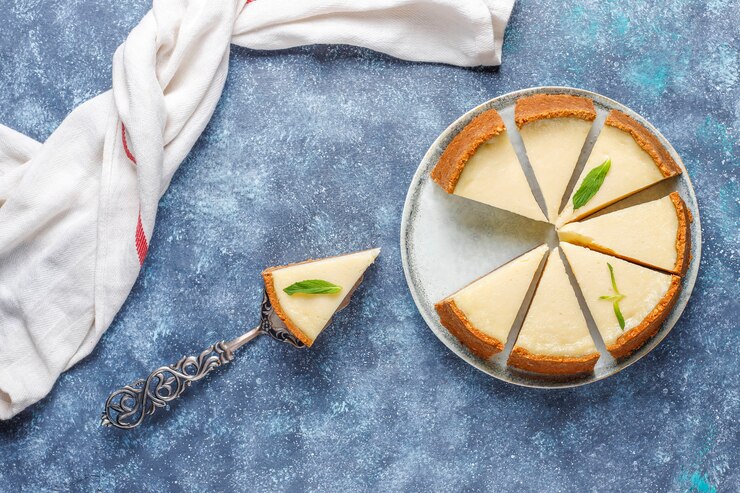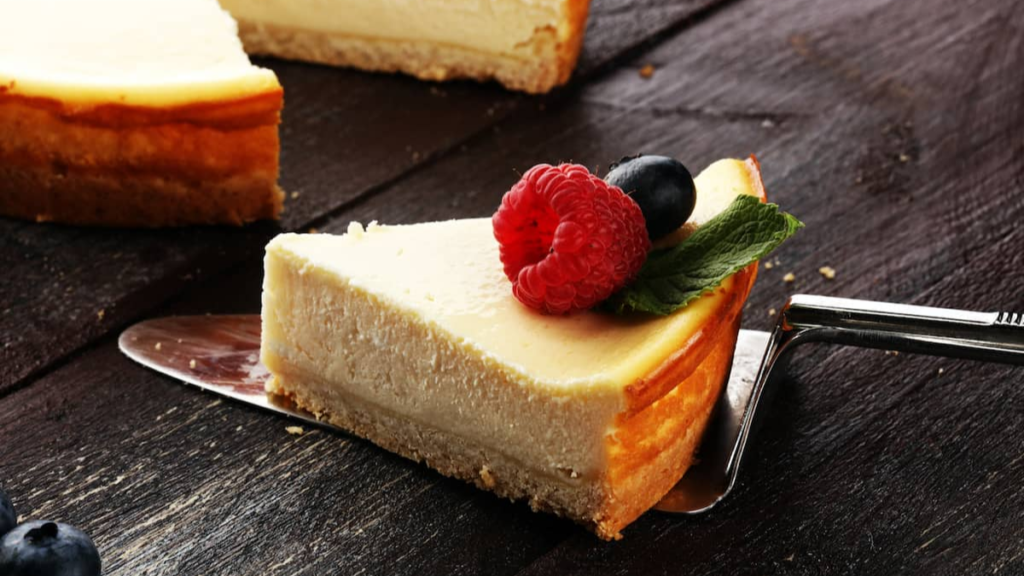If you are wondering how to tell if cheesecake is bad; The cheesecake ingredients are eggs, cream, cheese, and flavorings, and all have a short shelf life. If left out at room temperature, the cheesecake will inevitably go wrong and become unsafe to eat. Because of the high moisture content and perishable components, cheesecake is an ideal breeding habitat for visible mold and unseen bacteria like listeria and salmonella, which are difficult to detect with the human eye but harmful. Unfortunately, the cheesecake does not last long before it goes rotten. Leaving it out on the counter for a few hours is enough to convert your delectable dessert into a breeding ground for harmful bacteria.
A cheesecake is composed of ingredients that are easily spoilable. It’s a thickened custard made with soft, fresh cheese (typically cream cheese, ricotta, or quark), cream, eggs, and flavorings. There is no specific mention of cheesecake on the Food and Drug Administration’s storage chart for egg products.
How to Tell if Cheesecake is Bad?
Cheesecake has a short shelf life, so it’s easy to determine if it’s gone wrong. In as little as a few hours, the indicators of a stale cheesecake will appear. When inspecting the cake for freshness, keep the following in mind:
Aging
Fresh cheesecake usually has smooth, even edges and soft, mellow cheese. On the other hand, the stale cake will have crusty and broken edges, rubbery cheese will feel and taste, and other toppings may also have an odd flavor.
Discoloration
Fresh cheesecake will turn an unappealing yellow and may have some grey spots. Do not consume the rest of the cake after scooping off the discolored pieces. A change in hue is frequently a symptom of bacterial activity, and eating such cake can get you sick.
Foul Smell
If you take one glance at a cheesecake, you can usually tell if it’s gone wrong. However, if you want to be sure, give the cake a thorough sniff to see if it’s still fresh. If the cake smells like stale dairy products, toss it out immediately. Another symptom of bacterial activity is if the cake starts to exude liquid.
Mold
It is a solid sign that something has gone wrong. It spores will grow when a cake is left at room temperature for longer than two hours. Because of the moisture, leaving the cake uncovered in the fridge might cause mold to form. Just because the mold spores aren’t visible doesn’t mean the cake is safe to eat. Unrefrigerated cheesecake will quickly attract bacteria, so it’s best to be safe and throw it out.
Types Of Cheesecakes
The four major types of cheesecakes you need to know about are as follows:
Baked Cheesecake-Cream cheese, eggs, and sugar are commonly used in baked cheesecakes. The eggs have a shorter shelf life than others since they are prone to spoilage.
No-Bake Cheesecake-Cheesecakes that have been frozen rather than baked are known as no-bake cheesecakes. These are usually just cream cheese and heavy cream, and they last a lot longer than the others.
Store-Bought’s-an interesting fact: store-bought cheesecakes freeze and survive much longer than home-baked cheesecakes! This is because they have added preservatives for a more stable structure.
Home-Baked: The best way to enjoy a freshly made cheesecake is to eat it immediately. Due to the lack of preservatives, they begin to lose their flavor and dry out after a few days in the refrigerator.
How To Store Cheesecake?
Proper storage will keep cheesecake flavorful and safe to eat. Here are some tips for storing both store-bought and homemade cheesecake:
Tightly Wrap With Plastic Film
When it comes to preserving cheesecake, the idea is to keep it as dry as possible while also protecting it from taking up tastes from other foods in the fridge. After you’ve cut and served the slices you need, firmly wrap the remaining cake in cling film, and make sure there are no gaps where moisture can enter.
Store In An Airtight Container
For storage, airtight containers are a fantastic alternative to freezer bags. If resealable bags aren’t an option, keep the cheesecake in an airtight container. Before inserting the slices inside the container, it’s good to cover them with plastic wrap.
Refrigerate As Soon As Possible
Whether you prepared or bought the cake, please put it in the fridge as soon as possible and keep it there until ready to use it. The cheesecake can only be left out at room temperature for two hours, and any longer than that, the cake will be unsuitable for eating due to possibly harmful bacteria. If wrapping the cake without destroying the surface proves problematic, set the cake in a sheet pan, cover it with plastic wrap, and keep it in the refrigerator for no more than seven days.
Freeze For Longer Freshness
Slices of cheesecake or the entire dessert can be frozen. When you come home, put the ready-made cheesecake in the refrigerator. Wrap the cake in aluminum foil and place it in the freezer for up to two months to freeze. Thaw and chill the cake for up to seven hours in the refrigerator before serving when you’re ready to eat it. We’ll go through how to freeze cheesecake in greater detail later.
How Long Is Cheesecake Good In The Fridge?
Cheesecake freezes well. You can extend the shelf life and keep cheesecake safe to eat by freezing it. Follow these steps to freeze cheesecake:
- Tightly wrap individual slices of cheesecake with aluminum paper. Careful place in the freezer and allow to freeze until you are ready to eat.
- Sometimes cheesecake can be too squishy to wrap, and you can solve this by placing the cake on a sheet pan and freezing it.
- Take each piece of frozen cake, wrap it with plastic film, and put the individual slices in a resealable freezer bag.
- Consider making a cupcake-sized cheesecake that you can eat on a needs basis. You can bake just enough and avoid throwing out an entire cake that has come up to its shelf life.
- When you are ready to eat it, bring out the cheesecake from the freezer and allow it to defrost in the fridge overnight. You can let the cake thaw at room temperature for 20 to 40 minutes for immediate use.
- Remember to write the date when you froze the cake. This way, you can keep track of how long the cake has been in the freezer and check for freshness when you are ready to eat.
Keep in mind that freezing can alter the texture and taste of food, including your cheesecake. Although freezing will preserve the cake for up to 3 months, we recommend finishing the cake in less than a month.
What Happens If You Eat Moldy Cheesecake?
Cheesecake is only suitable for a few days after it is made. Even the most carefully preserved cheesecake will be a forerunner of bacterial activity by the end of one week. Let’s say that eating outdated cheesecake carries significant risk. Bacteria including Salmonella Enteritidis, E. coli, and Campylobacter will reside in your cake.
Consumption of these harmful bacteria might result in significant bacterial infections with symptoms such as stomach pain, vomiting, fever, nausea, and dehydration. You should discard the cake if you observe even the tiniest sign of spoilings, such as a terrible odor or flavor, leakage, discoloration, or mold.
Conclusion
Cheesecake is susceptible to bacterial activity, which means your beloved dessert will spoil quickly. Refrigeration will keep the cake fresh for a few days longer, but it should be eaten or tossed after one week. Avoid eating any cake that shows indications of rotting or has been left out at room temperature for longer than two hours.
If properly preserved, a regular cheesecake can survive up to seven days after being opened. Freshly manufactured, frozen, or homemade cheesecakes, on the other hand, will keep in the refrigerator for 6 to 8 days after the last printed date. Similarly, it can be frozen and kept fresh for 6 to 8 months. Check the internal temperature with a quick-read thermometer to see if it’s done. Insert the probe halfway into the cake; a baked cheesecake should register 150 degrees Fahrenheit.

